|
| |
|
Antiquing Across the Pond
by Bob Brooke
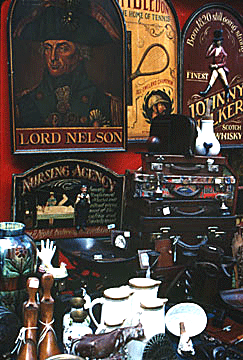 Antiquing
is a worldwide phenomenon. But nowhere in the world is it more a part of
the social fabric than in England. Antiquing
is a worldwide phenomenon. But nowhere in the world is it more a part of
the social fabric than in England.
Just as here at home, the antiques business is lagging due to a surge in
online auctions economy and over-inflated prices. Many American dealers,
such as John Wilson of Wayne, Pennsylvania, have all but given up buying
in England and now buy most of their English pieces here in the U.S.
It's not just the artifacts of any particular period which carry a
premium. Olive Branch Antiques typifies the kind of British bric-a-brac
shop where you may go to browse and touch. "Customers," said the
salesgirl, Angela, "like to look under tables and reach on top of
cupboards. I don't mind." It would be difficult for anyone not to pick
up something or other: old keys, cups and saucers, hickory-shafted golf
clubs, or a lace tea-tray mat selling for no less than $20.
"Olde Worlde" serendipity? Perhaps, but England isn't the place to go
bargain hunting in hopes of making a financial killing. Values of most
antiques are known, as they are here at home. It's much better to trust
to instinct and buy what you like if it's affordable.
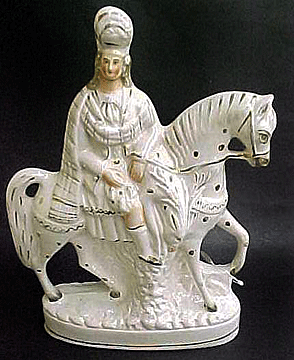 Then
again, it's possible to choose something whose value is appreciating.
The demand for Scottish handpainted Wemyss china, for example, has
skyrocketed. So has all Staffordshireware and other types of Victorian
majolica. Then
again, it's possible to choose something whose value is appreciating.
The demand for Scottish handpainted Wemyss china, for example, has
skyrocketed. So has all Staffordshireware and other types of Victorian
majolica.
Prices at some of the better-known flea markets, such as London's
Portbello Road, are in the stratosphere. More of a tourist trap than an
antique-hunters’ paradise, it offers lots of reproductions, especially
of Staffordshire dogs and other high-priced items, which to the unwarry
shopper look like the real thing.
A pair of 12-inch turned wooden candlesticks was selling for $50. And on
the same table was a stereopticon bears a price tag of $232. Tea
caddies, always a favorite of Anglophiles, were selling for $210
minimum. Eye cups, selling for $5 to $20 in the U.S., start at $45 in
the U.K.
What Makes Antiquing in England
Different?
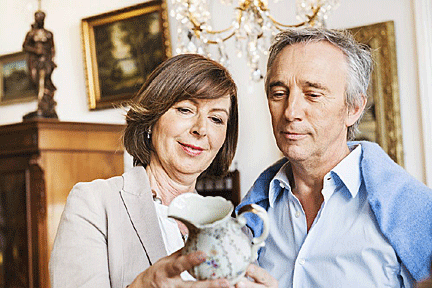 But
there's something especially British about antiquing here, regardless of
the prices. British antique dealers, on the whole, are tolerant. They
don't pressure their customers to buy. Michael Golding of Huntington
Antiques of Stow-on-the-Wold in the Cotswolds accepts his role as an
impromptu guide with good grace. "Visitors," he said, "treat us like a
museum. They tell us that they've seen more here than in Warwick
Castle." But
there's something especially British about antiquing here, regardless of
the prices. British antique dealers, on the whole, are tolerant. They
don't pressure their customers to buy. Michael Golding of Huntington
Antiques of Stow-on-the-Wold in the Cotswolds accepts his role as an
impromptu guide with good grace. "Visitors," he said, "treat us like a
museum. They tell us that they've seen more here than in Warwick
Castle."
That isn't so surprising, since his stock may include anything from an
early English, Gothic bed at $145,000 to a Limoges enamel book cover,
one of only two known to be in existence. Of course, there are items of
lesser cost, such as a 16th-century polychrome wood mortar and pestle
for about $4,000.
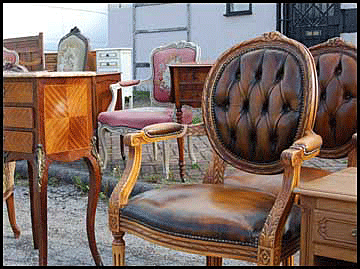 Even
in the most impressive surroundings, the price on the ticket is no more
than the starting point for negotiations. Customers rarely hear the word
"firm" in an English shop. Antique buying and selling is played by
bazaar rules. The trade price is always at least 10 percent less than
the marked figure. Even
in the most impressive surroundings, the price on the ticket is no more
than the starting point for negotiations. Customers rarely hear the word
"firm" in an English shop. Antique buying and selling is played by
bazaar rules. The trade price is always at least 10 percent less than
the marked figure.
At Picton House, Broadway, also in the
Cotswolds, a pair of decanters and six crystal sherry glasses stand on a
late 18th-century Sheraton sofa table. They aren't for sale, though the
table is. They're there for patrons who might enjoy a little refreshment
when making up their minds between a serpentine fronted mahogany chest
and a set of Queen Anne chairs. The look here is that of an English
country house, in its prime during the Edwardian era. Even in the
lowliest shop, there's a feeling of class that's often missing here at
home.
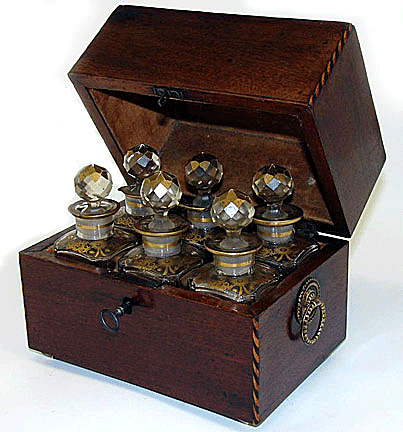 The
greatest difference between antiquing in England and here at home is the
broad division between the higher-end market and the provincial shows
and shops. "I would say that it is more stratified here," said Pat
Wilson, a dealer in the Stratford-upon-Avon Antique Centre, "there being
a vast social gulf between the up-market London dealers and those
scratching a living as "knockers," who go around knocking on doors
asking if the householder has any antiques for sale." The
greatest difference between antiquing in England and here at home is the
broad division between the higher-end market and the provincial shows
and shops. "I would say that it is more stratified here," said Pat
Wilson, a dealer in the Stratford-upon-Avon Antique Centre, "there being
a vast social gulf between the up-market London dealers and those
scratching a living as "knockers," who go around knocking on doors
asking if the householder has any antiques for sale."
To a degree, this is happening in the States, but in England, it's to
the exclusion of those customers that don't have a Mercedes or limo
waiting for them at the curb.
To keep ahead of the market some dealers have taken to "making" antiques
or to restoring pieces in such a way as to make the piece no longer
valuable as an antique. In some ways this also is much like it is here
in the U.S., but in England it's becoming even more widespread due to
the country's antique reputation and the demand for fine pieces.
Collectors should be careful when purchasing antiques in England today.
Often the interiors of writing boxes have been completely rebuilt,
replacing leather slopes, putting new fronts on drawers, and such
without notifying the buyer. This has become a very common practice in
England.
Where to Find Antiques in England
Even so, England is still the world's greatest antique treasure store.
Across the country, any day of the week, there may be several dozen
auctions and shows taking place. Even a small town will boast a couple
of shops. In historic centers like Bath, the numbers run into the
hundreds, not counting the stallholders packing specialty markets like
Guinea Lane.
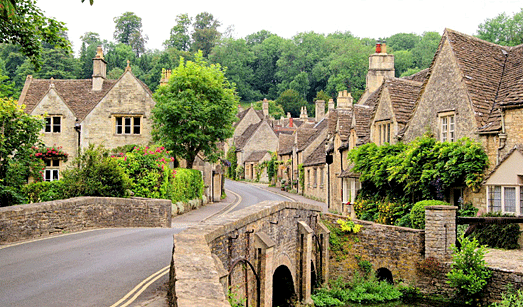
But by far the hottest antique trail
in England is the Cotswolds. More top dealers set out their wares
here than anywhere else outside the London and they're less formal
than their London colleagues. The towns of Stow-on-the-Wold,
Cirencester and Tetbury have barely changed for centuries.
Cheltenham Spa retains more than a vestige of Regency chic.
Burford's High Street, lined with limestone houses, is dotted with
antique and refinishing shops.
Also, many tourist towns like Warwick, Bath, and
Stratford-upon-Avon, have well-known antique markets.
 Cornwall
has some interesting, if lesser-known, antiquing possibilities. Not
traditionally an antique center, towns like Teignmouth, Exmouth,
Budleigh Salterton, Topsham, Woodbury and Exeter in the north and
Torquay, Paignton, Brixham, Totnes, Dartmouth and Kingsbridge in the
south all have enough shops to keep the avid antiquer happy for
days. Cornwall
has some interesting, if lesser-known, antiquing possibilities. Not
traditionally an antique center, towns like Teignmouth, Exmouth,
Budleigh Salterton, Topsham, Woodbury and Exeter in the north and
Torquay, Paignton, Brixham, Totnes, Dartmouth and Kingsbridge in the
south all have enough shops to keep the avid antiquer happy for
days.
A full day can be spent in Honiton, where it seems every other
building is an antique shop. Also, the Baribican in Plymouth, offers
antique markets and galleries by the harbordside along Southside
Street.
The types of English antique venues are as varied as their
locations. Superb antique galleries abound on London's Kensington
Church Street, Bond Street, and Belgravia, where high quality pieces
are displayed in an exclusive atmosphere. Other areas that are prime
antiquing centers include East Anglia with Woodbridge, Long Melford,
and Bury Saint Edmunds.
Besides the medium-sized modestly-priced shops found in most English
towns, there are also the house-clearance specialists, whose often
cluttered shops may yield some interesting finds, as well as the
thrift shops, piled high with goods donated to a good cause.
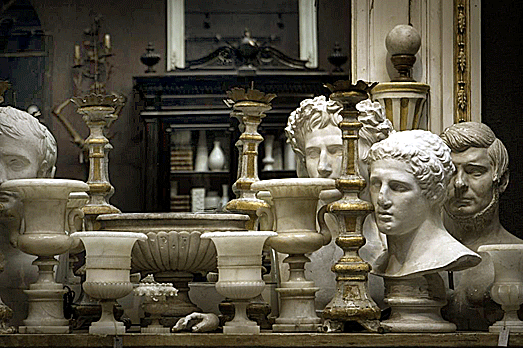
For those who can't afford the high overhead of individual shops,
there are plenty of indoor antique arcades or markets, with a dozen
to several hundred stalls. Many reside in attractive old buildings,
with individual locked cases or an open-plan arrangement. One of the
best is Alfies' on Church Street, in the Marylebone section of
London. Here, 150 dealers cram six floors full of everything from
pure antiques to "bygones"—what the
British call collectibles. There's also Antiquarius, Chenil
Galleries, and the Chelsea Antique Market on King's Road, Chelsea,
as well as Gray's and Gray's Mews on Davies Street, and Camden Lock
in Islington.
Antique Fairs
Antique fairs have grown tremendously popular in recent years. The
large London fairs—the National
Porcelain, Pottery, and Glass Fair, the London Antiques Dealers
Fair, and the Grosvenor House Antique Fair—offer
superb displays of fine pieces.
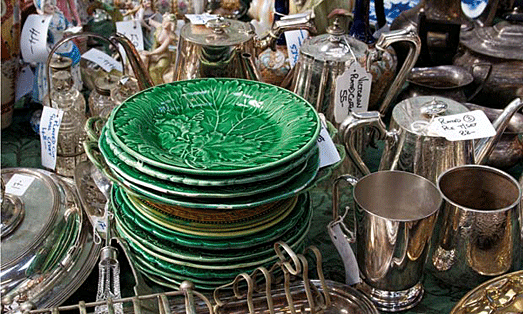
"'Dated' fairs [such as the Chelsea Antique Fair] are those where a
cut-off point for items on display is established, usually at the
latest 1880 or 1900," said Wilson of Stratford-upon-Avon, "though
with the increasing popularity of Art Nouveau and Art Deco, the
limit is sometimes raised to 1930 or 1940."
For those who wish to take in some of the opulence of England's
stately homes, there are fairs held in Castle Howard (famous for the
filming of "Brideshead Revisited"), Hatfield House or Ragley Hall.
Fairs are also held at many of London's top hotels, such as the
Kensington and London Hiltons, and the Royal Lancaster Hotel.
More affordable fairs take place on weekends in venues of every
type, from townhalls to parish rooms to school gymnasiums. These
offer more collectibles, much as the smaller country fairs do here
at home. A good example is the Winchester Antique Fair, held in the
11th-century guildhall in the center of town. Two floors of dealers
sell everything from picture frames to lamps. Admission charges
range from a dollar or so to over $20 for larger events.
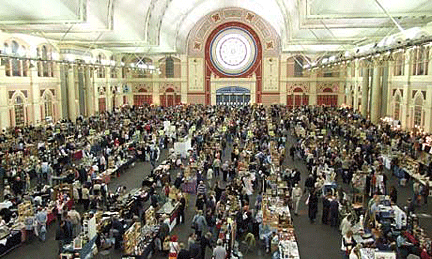 One
of the best and largest of the general fairs is the one held five
times yearly at the Alexandra Palace in North London. Known locally
as the "Ally Pally," this fair takes place on Sundays only and
features more than 1,000 dealers. Another, held on Wednesdays seven
times yearly in Saint Martin's Rag Market in Birmingham, and also
known as the "Birmingham Rag," has over a thousand dealers. One
of the best and largest of the general fairs is the one held five
times yearly at the Alexandra Palace in North London. Known locally
as the "Ally Pally," this fair takes place on Sundays only and
features more than 1,000 dealers. Another, held on Wednesdays seven
times yearly in Saint Martin's Rag Market in Birmingham, and also
known as the "Birmingham Rag," has over a thousand dealers.
The showground fair is a fairly new phenomenon in England. Held in
vast complexes that usually showcase agriculture or livestock, these
fairs attract an enormous number of exhibitors who set up either
inside the halls or in the surrounding fields. Similar to our
extravaganzas held twice yearly, these fairs offer all levels of
antiques, from top quality items to junk.
England also has shows for collectors of a particular period or
item, much as we have here. "Art Deco shows have become increasingly
popular," added Wilson, who specializes in the period. In addition,
auction houses are developing theme auctions aimed at collectors of
specific items, particularly pottery.
British Flea Markets
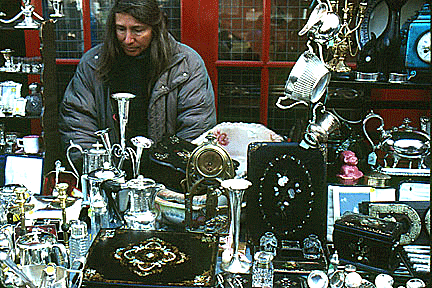 Flea
markets attract everyone from diehard antique addicts to casual
browsers. A mixture of young and old of all races and nationalities,
from young couples with baby strollers to empty- nesters, all
looking, looking, looking for that special find while folk musicians
entertain and hawkers sell T-shirts. It's more like a carnival
atmosphere--a great "day out" for everyone. Flea
markets attract everyone from diehard antique addicts to casual
browsers. A mixture of young and old of all races and nationalities,
from young couples with baby strollers to empty- nesters, all
looking, looking, looking for that special find while folk musicians
entertain and hawkers sell T-shirts. It's more like a carnival
atmosphere--a great "day out" for everyone.
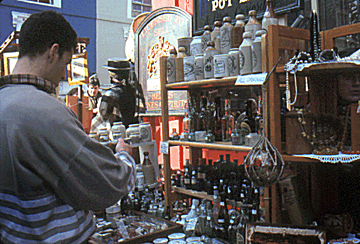 Portobello
Road is probably the most well known. Here itinerant dealers set up
shop on Saturdays in front of regular antique shops along narrow
Portobello Road and its various side streets. Alongside collectibles
such as royal commemorative cups and saucers and Bohemian glass
etched vases, vendors sell handmade straw hats and jewelry. But
there is a bright spot for dedicated antique shoppers if they take
the time to find it. Portobello
Road is probably the most well known. Here itinerant dealers set up
shop on Saturdays in front of regular antique shops along narrow
Portobello Road and its various side streets. Alongside collectibles
such as royal commemorative cups and saucers and Bohemian glass
etched vases, vendors sell handmade straw hats and jewelry. But
there is a bright spot for dedicated antique shoppers if they take
the time to find it.
Other markets in London include the New Caledonia Market, also known
as the Bermondsey Market and also a Saturday market at Long Lane and
Tower Bridge Road, four blocks south of the Tower of London, and the
Petticoat Lane Market, a Sunday-only market, about the same distance
north. Several others, including Camden Passage in Islington and the
Church Street Market near Alfies, are open all week, but the best
day to visit is Saturday.
There's a lot of antique stealing and fencing going on in Britain
today. Unfortunately, for the buyer, English law states that a
stolen item remains the property of the owner however many hands it
passes through. Caveat Emptor, buyer beware. It's crucial for anyone
spending serious money on antiques in England to make sure they
receive a full, detailed invoice describing the purchase. British
Customs demands it.
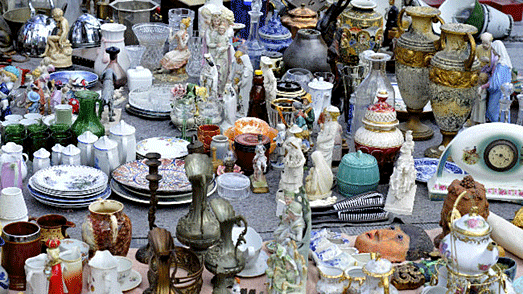
Acquiring an object off a market stall or at one of the growing
number of tailgate sales can be risky. While that risk, itself, may
contribute to the thrill of antique hunting, it's safer even when
looking for inexpensive collectibles to choose a well-run market
like the Cotswold Antiques Centre in Stow-on-the-Wold, whose 20
dealers guarantee every item on sale. It's always better to spend a
dollar or so more, than to be sorry.
< Back to Collecting Archives
Next
Article >
|
|

|
|
FOLLOW MY WEEKLY BLOG
Antiques Q&A
JOIN MY COLLECTION
Antiques and More
on Facebook
LIKE MY FACEBOOK PAGE
The Antiques
Almanac on Facebook |
|
No antiques or collectibles
are sold on this site.
|
|
How to Recognize and
Refinish Antiques for Pleasure and Profit
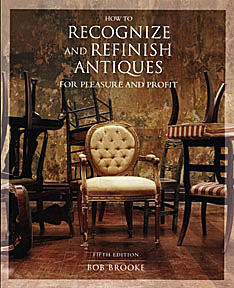
Have
you ever bought an antique or collectible that was less than perfect and
needed some TLC? Bob's new book offers tips and step-by- step
instructions for simple maintenance and restoration of common antiques.
Read an
Excerpt
|
|

|
|
|
|
|
